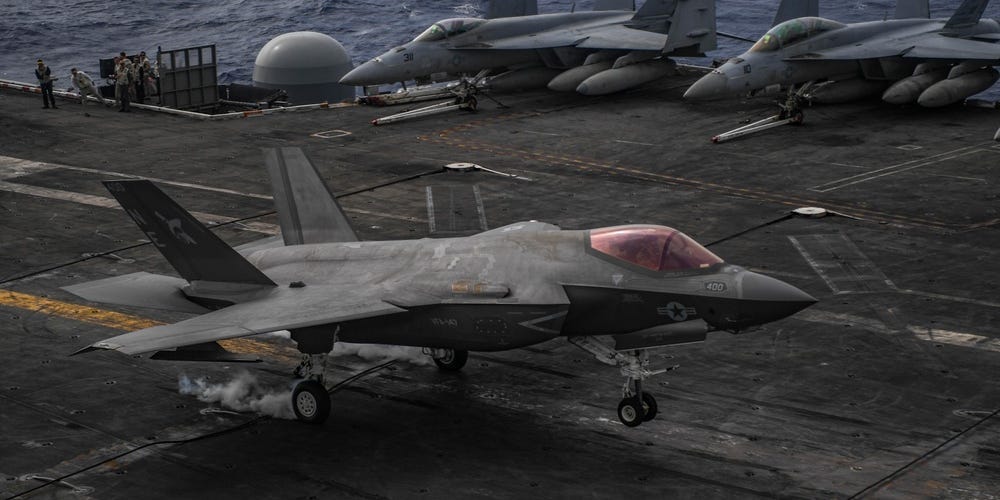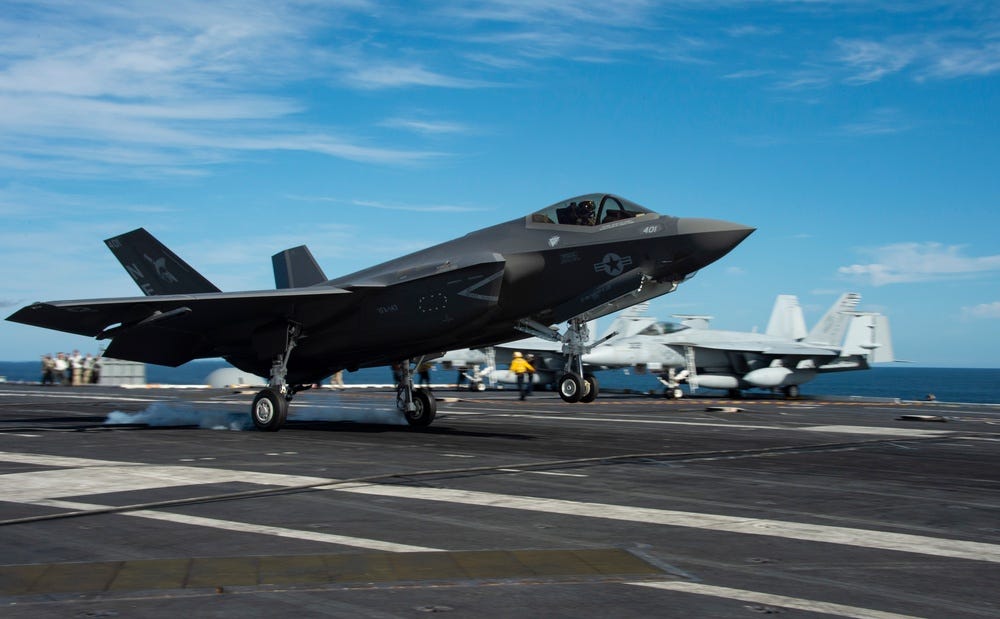
- An F-35C stealth fighter crash-landed on the deck of carrier USS Carl Vinson before falling into the South China Sea this week.
- The US must now salvage the sunken aircraft to make sure that no one else gets their hands on it.
- Experts say it may take a few weeks to recover the plane.
The US Navy is working to recover an F-35C fighter — one of the US military's most advanced jets — that crash-landed on the Navy aircraft carrier USS Carl Vinson before falling into the South China Sea earlier this week.
The "landing mishap," as the Navy characterized the crash in an official statement, occurred Monday during routine flight operations. The pilot ejected and was recovered by helicopter. Seven sailors were injured in the incident, which is under investigation.
The US presently faces the challenge of pulling the wreckage out of the contested waters of the South China Sea to recover US technology, as well as make sure no one else can get their hands on the plane. "The planning efforts are ongoing for the recovery of the F-35," a 7th Fleet spokesman told Insider.
Experts say China would almost certainly want to get ahold of the F-35, a highly-capable fifth-generation fighter jet that has taken many years and significant funding to research and develop.
"There's a huge opportunity for the Chinese if they were able to get a copy of an actual F-35 to reverse engineer its features, which they can't do just based on the intelligence gathering they've conducted," said Bryan Clark, a former US Navy submarine warfare officer and defense expert at the Hudson Institute.
"Maybe the bigger concern is if they got ahold of an actual F-35, it would help them to figure out how to better counter it," he continued. China is actively developing and fielding its own fifth-generation fighters, such as the J-20, to compete with the US.
The Navy F-35C has been touted by Lockheed Martin as "the world's only long-range stealth strike fighter designed and built explicitly for Navy carrier operations." One of three variants, the F-35C has an extended combat radius and is capable of catapult-assisted take-offs and arrested landings.

Although getting their hands on an F-35 would be a major intelligence boon for China, Clark thinks it is unlikely they would risk an altercation with the US trying to get this one, though there is the possibility they might try if the US took too long to salvage the plane.
However, the Chinese military is likely to search for the plane and gather as much intelligence as they can, Carl Schuster, a former director of operations at US Pacific Command's Joint Intelligence Center in Hawaii, told CNN.
"China will try to locate and survey it thoroughly using submarines and one of its deep diving submersibles," he told the outlet.
To recover the sunken F-35, the US will likely search the seafloor with survey vessels before using ROVs — remotely operated vehicles — to attach cables to the aircraft in order for cranes to lift it out of the water.
The operation will probably take a few weeks, Clark said, and during that time, the US will be closely monitoring the area.
"The US has had to retrieve airplanes, weapons, and in one case, a Russian submarine off the seafloor – so it's certainly doable," Clark said, but the recovery mission may be made more difficult if the plane is not intact or if another country impedes the operations in any way.
Clark speculated that there may "be a bunch of Chinese maritime militia boats in and around you, watching you, getting in the way, maybe harassing you, making it difficult to get the job done."

Retired Marine Corps officer and current senior advisor for the Center for Strategic and International Studies' International Security Program Mark Cancian told the Navy Times that the actual process of raising the plane from the water would be "relatively easy," as the South China Sea is not very deep.
Cancian also told the outlet he believes the plane is largely intact because it impacted the carrier deck before falling into the water.
"It sounds like it hit the deck hard and rolled off the edge, it didn't go into the water at speed," he told the Navy Times. "It gets much harder if it's in a thousand pieces.
This is one of only about half a dozen F-35 crashes and only the second involving a carrier. The previous carrier incident happened in November 2021, as Insider previously reported. A British pilot operating off the Royal Navy flagship carrier HMS Queen Elizabeth was forced to ditch the plane in the Mediterranean.
The wrecked F-35B took about two weeks to find and then another few weeks to pull from the water, the British newspaper The Sun reported. Senior military leaders had reportedly been worried Russia would find the remains if they were not properly recovered. Russia, like China, has also been developing and fielding its own fifth-generation fighters.
Officials told the British media outlet after the successful recovery that "there is no danger or compromise to sensitive equipment on the aircraft."